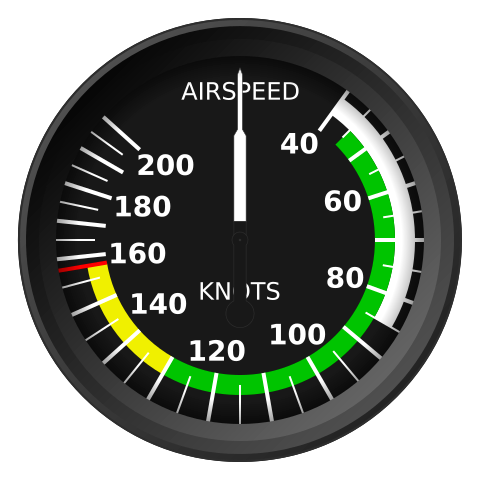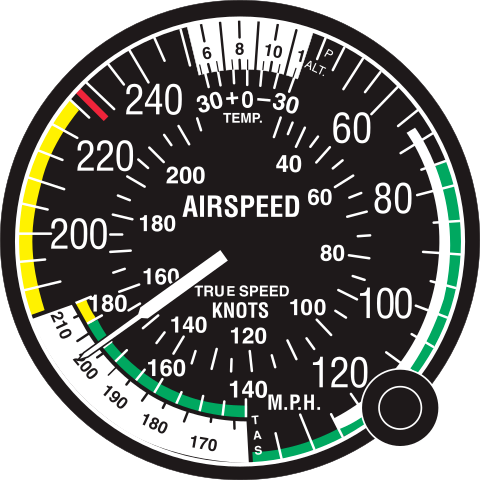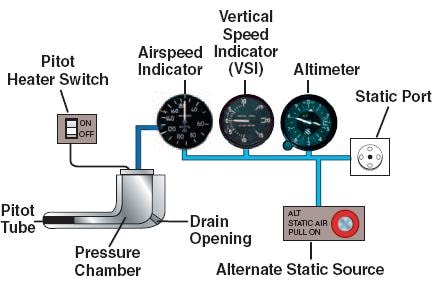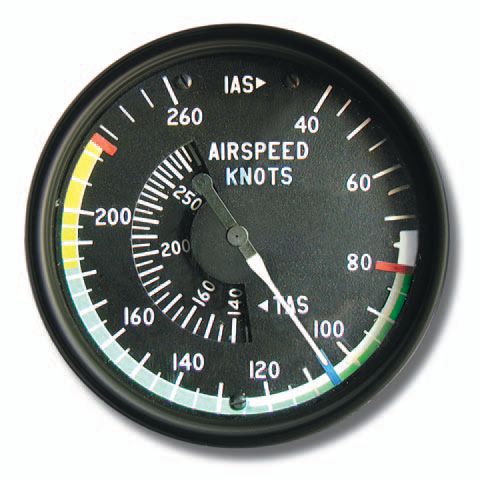Airspeed Indicator Errors: How to Identify and Fix Them
Oct 23, 2024
What Are Airspeed Indicator Errors and Why Is It Important to Know?
Airspeed indicator errors are the inaccuracies in the speed reading on the instrument, caused by instrument calibration issues, pitot tube blockages or changes in air density and pressure.
Pilots need to understand these errors as accurate airspeed is key to safe flight, to prevent stalls or overspeed.
By knowing the potential errors and how to spot them, you can make informed decisions and have better control of the aircraft and have a safer and more predictable flight.
Understanding Airspeed Indicators
Understanding airspeed indicators is key to controlling and being efficient in flight. This instrument puts the power of speed awareness right at your fingertips so you can know how fast you’re flying in knots.
By learning to read this tool accurately you can fly all sorts of airspace safely for yourself and your passengers. But how does an airspeed indicator work? The airspeed indicator is cleverly designed to account for changes in altitude, air density, and dynamic pressure, which can affect an aircraft’s performance.
This allows you to understand and adapt to changing conditions in the air, whether climbing or descending. This is key to being efficient at different phases of flight and for smoother and more planned transitions.
And it’s not just about reading numbers; it’s about being proactive with flight safety. Pilots who can interpret their airspeed indicators are better prepared for what might happen in flight. This subtle understanding not only makes you a better pilot but a safer one for everyone on board.
Airspeed Definitions

Indicated Airspeed (IAS)
Indicated Airspeed (IAS) is your primary reference point in the cockpit, giving you real time data to make decisions during flight. It shows the direct reading from the airspeed indicator but doesn’t take into account temperature or air density. That’s the beauty of it, you can make quick decisions and always be in control of the aircraft, safety of flight.
But IAS has its limitations. Instrument and installation errors in the pitot system can affect its accuracy. Though small, these errors require pilots to understand their aircraft systems and potential errors. By being aware and cross checking with other airspeeds when needed, you can mitigate these issues and have a smoother and safer flight.
Calibrated Airspeed (CAS)
Calibrated Airspeed (CAS) is better because it corrects for the errors in the pitot-static system which can be affected by many flight conditions. Indicated Airspeed (IAS) is the base figure, CAS adds in the necessary adjustments for system induced errors to give a more accurate picture of the aircraft’s performance. This is especially important at lower speeds where accuracy is key, like takeoff and landing.
CAS is important for pilots to fly safer and more efficiently. It closes the gap between indicated and true airspeed so pilots can make better decisions based on real world conditions.
By considering air density and temperature CAS helps pilots' control and comply with performance limits. This informed approach is safer and more confidence inspiring so pilots can fly through different weather conditions with more ease.
Equivalent Airspeed (EAS)
EAS is an aviation term that means the corrected airspeed of an aircraft. It’s the calibrated airspeed adjusted for compressibility. When flying high speed aircraft EAS becomes very important.
The measurement of EAS gives the pilot a more accurate indication of the aircraft’s speed. That’s important for safe and controlled flying in all conditions.
EAS determines an aircraft’s actual airspeed by considering things beyond just speed. It accounts for air density and temperature which affect performance.
With EAS pilots can make better decisions and fly safer and more efficiently. They can fly in all conditions with confidence.

Airspeed Indicator Components
Pitot Tube and Static Port
The airspeed indicator is a vital part of the cockpit, it relies on both the pitot tube and the static port to work. These two work together to give the pilot accurate speed readings so the aircraft can be flown safely.
The pitot tube is an “L” shaped and faces into the oncoming wind. As the aircraft moves, the pitot tube collects air to measure the ram air pressure, while the static port measures the local air pressure, which is a key part of calculating speed.
The static port captures static air, which is essential for the functioning of the airspeed indicator and other pitot-static instruments.
On the other hand, the static port is located on the side of the aircraft in an area of least turbulence. It measures the ambient air pressure which is key to calculating static pressure.
The pitot tube and static port connect through what’s called the pitot-static system. This system feeds the airspeed indicator with reliable data so the pilot can fly with precision.
Common Errors and Limitations
Instrument Errors
Instrument errors can come from many places. One common issue is pitot tube blockage, which can be caused by ice, dirt, or insects, leading to incorrect airspeed readings. These are mostly due to instrument failure or environmental conditions that interfere with the data. Pilots need to be aware of these to fly safely.
A common source of instrument errors is a faulty pitot tube. If the pitot tube is not working right, it will not get the ram air pressure and will give you wrong speed readings. This can be a big problem during critical phases of flight.
And the static port can also cause instrument errors. The static port measures ambient air pressure which is used to calculate static pressure. If the static port is blocked or malfunctioning it will give you wrong airspeed indicator readings.
These instrument errors will give you wrong airspeed indicator readings which will affect your ability to maintain airspeed. Wrong readings will make flight operation difficult especially in bad weather.
Pilots need to understand and mitigate instrument errors. By being aware and doing regular checks pilots can minimize the impact of these errors and get more reliable data from their instruments and ultimately flight safety and efficiency.
Blockages and Ice
Blockages in the pitot tube or static ports can cause the airspeed indicator to read incorrectly. This instrument is critical to safe flying. Blockages stop the air pressure from being measured correctly.
Ice is a common cause of blockages. When ice forms in the pitot tube or static ports, it can ruin the airspeed reading. Pilots need accurate data to fly safely especially during takeoff and landing.
There are several reasons why blockages can form from ice, weather is a big one. Flying through freezing rain or snow can cause ice to build up on critical areas.
Apart from environmental factors, maintenance is also a cause of blockages. Regular inspection and maintenance are key to preventing faults from dirt, debris or wear and tear.
Fixing blockages and ice is top priority for pilots and maintenance crews. Knowing the causes and effects means aviation professionals can take preventative action and fly safer and more reliably.

Error Identification and Mitigation Strategies
Identifying Errors
Identifying errors in the airspeed indicator is key to flight safety and starts with understanding how the instrument works and how the parts fit together. That means understanding how external and internal factors can cause discrepancies in the readings.
Pilots need to be able to tell the difference between normal variations and real malfunctions, a skill that comes from training and experience in recognizing different types of errors, position error, instrument error and environmental conditions.
Regular maintenance and inspections are the best way to catch problems early. By checking for blockages or damage in the pitot tube and static port, such as pitot tube blockage, maintenance crews keep the readings as accurate as possible.
Proactive measures like cleaning components and replacing worn parts can prevent problems that cause incorrect speed indications. This combined with pilot vigilance is key to safe and efficient flying and gives crew and passengers a sense of security and reliability.
Mitigating Errors
Fixing airspeed indicator errors starts with having a technical foundation. That means understanding how the airspeed indicator works, how it’s affected by different flight conditions and what the errors mean for flight performance.
Training should focus on real world scenarios where pilots can practice recognizing and reacting to deviations. By getting hands on experience pilots develop the confidence and skills to make quick decisions in the air and be proactive not reactive to errors.
Beyond training a culture of routine maintenance and inspection is key to airspeed indicator reliability.
Maintenance teams play a big part in this by doing systematic checks to identify and fix potential issues before they affect the instrument’s accuracy.
Scheduled inspections ensure all parts from the pitot tube to the internal mechanisms are working as they should. This attention to detail not only keeps you safe but also creates an environment where pilots and passengers can trust the aircraft’s performance and everyone’s safety is paramount.
Practical Applications of Airspeed Knowledge
Knowing airspeed in detail means you can optimize your aircraft’s performance in all conditions. Knowing when to adjust airspeed makes a big difference to fuel consumption, so not only is it more efficient but also more sustainable.
By flying at the right speeds, you’re reducing fuel use and emissions, helping the environment. This goes beyond the mechanical and into real world benefits, so you can align operational efficiency with environmental responsibility.
And a deep understanding of the different types of airspeed – indicated, true and ground speed – means you can navigate different flight scenarios better.
Each type of airspeed gives you different information; true airspeed helps you understand the aircraft’s speed through the air mass, which is important when flying high.
Ground speed tells you about the progress over the earth’s surface, which is key to flight planning and getting to your destination on time. This broad understanding of airspeeds means you can respond to air traffic control instructions better and be safe and on time every time.

Additional Resources
Reading the aircraft’s manual is a goldmine of information specific to your aircraft model so you know your aircraft inside out. It’s more than just a set of instructions, it’s a guide to mastering your instruments to increase safety and efficiency.
Talking to a qualified aviation professional will also add to this knowledge and address any questions you have, so you feel confident and precise every flight.
The digital age has given us new ways to learn through online tutorials and training programs so advanced learning has never been more accessible.
These resources offer self-paced study and often include interactive elements to help you learn through practical hands-on experience.
By using these educational tools regularly pilots reinforce their knowledge and stay up to date with the latest aviation technology, a culture of continuous improvement and a commitment to excellence in their profession.
Comprehensive Overview of Airspeed Indicators
You can’t fly safely without understanding airspeed indicators. This instrument tells you how fast you’re moving through the air, a critical factor for control in all phases of flight. Proper airspeed prevents bad things from happening.
Airspeed indicators use tubes and sensors. Air enters a pitot tube when the aircraft moves, and that pressure change tells you the speed. Pilots rely on those readings to make decisions.
Pilots need to know the difference between airspeeds. Indicated Airspeed (IAS) comes straight from the gauge, True Airspeed (TAS) adjusts for altitude and temperature. Knowing that helps you fly more accurately.
It takes practice to get good with airspeed indicators. With experienced pilots to help even a beginner can get proficient. Knowing this tool ensures safety and makes flying more enjoyable and safer.

Common Misinterpretations and Clarifications
Many people think airspeed indicators show the plane's actual speed over the ground. This is not true. They only measure speed through the air, not accounting for wind or other factors.
Some pilots may confuse Indicated Airspeed (IAS) and True Airspeed (TAS). IAS comes straight from the gauge and does not adjust for things like air density. TAS gives a more accurate speed, using altitude and temperature adjustments.
A common mix-up is believing the airspeed indicator's reading is always precise. In reality, its accuracy can be influenced by changes in the plane's angle or air pressure conditions.
Finally, pilots sometimes overlook how important it is to understand these differences. Knowing them helps pilots make better decisions and keeps everyone safe in the air.
Integrating Airspeed Data with Modern Avionics
Modern avionics makes flying easier and safer. With airspeed data you get real time updates to help you make better decisions. These systems give you alerts if you’re too fast or too slow, so you stay on track.
Airspeed data is used in modern avionics through automation. These systems adjust settings for you, so you don’t have to. So, you can focus on other important things.
And another benefit is better navigation. Airspeed data helps you plan your flight path more accurately and efficiently. With precise speed you can optimize fuel and react faster to changing weather, smoother flights and save time.
Lastly integrating airspeed with avionics makes overall flight safer. With more data you can anticipate issues earlier. This proactive approach lets you handle challenges better, so everyone’s journey is safer and more fun.

The Role of Airspeed in Emergency Situations
In emergencies, knowing the plane's airspeed is vitally important. Airspeed helps pilots understand how the plane is behaving in the sky. It tells them if the plane is moving too quickly or too slowly, which can affect how they handle the situation. Quick and correct decisions often depend on accurate airspeed information.
If a plane is flying too slowly, it can risk stalling, which means losing lift and potentially falling from the sky. By monitoring airspeed, pilots can prevent this from happening. Ensuring the plane stays at the right speed helps maintain control and increases the chances of safely resolving the emergency.
During an emergency, high airspeed can also be dangerous. If the plane is going too fast, it may not be able to turn or descend safely. Pilots use airspeed data to adjust the plane's controls to manage the situation while keeping passengers safe.
Overall, airspeed is a critical tool for pilots during emergencies. It provides essential information that helps them make split-second decisions.
This makes air travel safer and gives passengers and crew confidence in the pilots' ability to handle unexpected situations.
In an emergency, airspeed is crucial. Airspeed tells you how the plane is behaving in the air. It tells you if you are going too fast or too slow and that affects how you handle the situation. Quick decisions often depend on airspeed information.
If you are going to slow the plane can stall and lose lift and potentially fall from the sky. By monitoring airspeed, you can prevent that from happening.
Keeping the plane at the right speed helps you stay in control and increases the chances of getting out of the emergency.
High airspeed can be dangerous in an emergency too. If the plane is going too fast, it may not be able to turn or descend safely. Pilots use airspeed data to adjust the controls to manage the situation while keeping passengers safe.
In summary airspeed is a vital tool for pilots in emergencies. It gives them the information they need to make split second decisions. That makes air travel safer and gives passengers and crew confidence in the pilots to handle the unexpected.
Conclusion and Key Takeaways
The airspeed indicator is the backbone of navigation in an aircraft. By giving you real time speed data you can control and adjust as needed to ensure every flight is safe.
Understanding airspeed is not just a technical requirement but knowledge that allows you to get the most out of your aircraft.
This knowledge helps you fly fuel efficient and follow air traffic control procedures smoothly, so overall flight operations are better.
Just as important is the commitment to regular maintenance and thorough inspections which are the guardians of accuracy for the airspeed indicator.
By doing these preventive measures any errors can be caught and fixed before they happen, and the instrument will be more reliable.
This proactive approach breeds a culture of safety and excellence in aviation so pilots can fly with confidence and precision.
By doing these practices we can fly sustainably where efficiency and safety go hand in hand.

